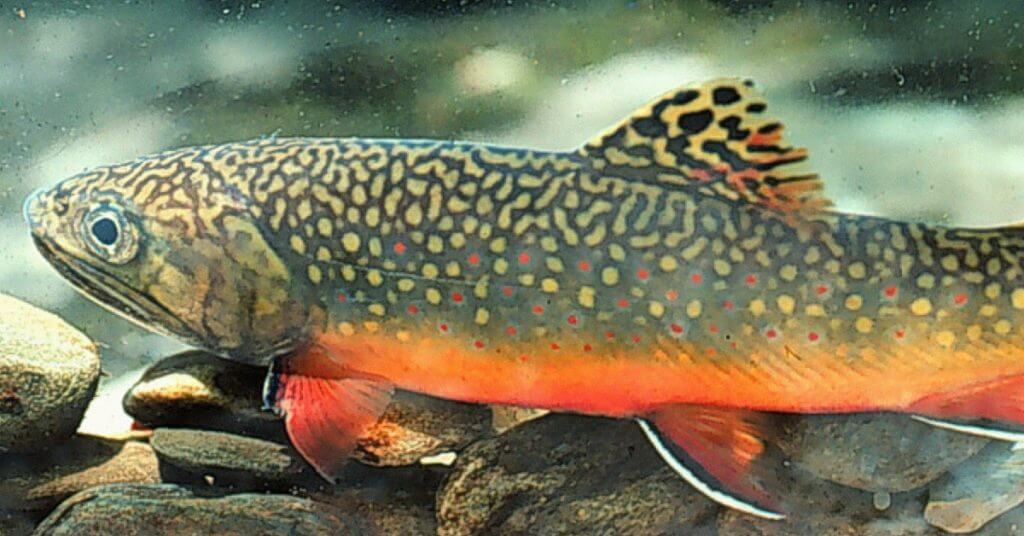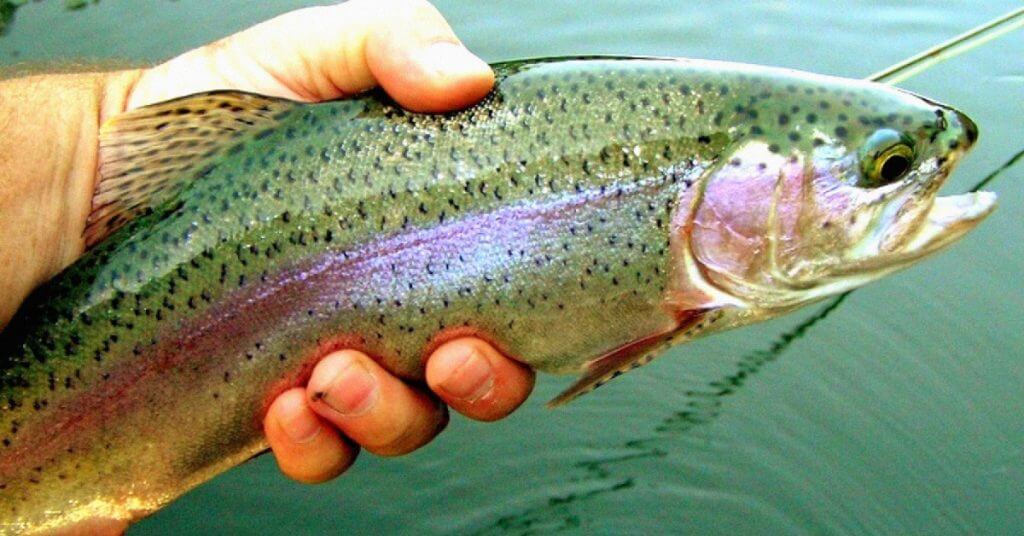While this article covers 13 types of trout, there are many more subspecies and mutations out there. The truth is, many of us will never see most of these trout. Some are super rare while others are common.
Either way, I’ve been trout fishing since before I could spell “trout.” They’re a fun game fish to target, catch, and eat. These are likely the reasons that make them one of the most popular game fish in the country.
By the end of this article, you will know more about trout than you ever thought possible.
Table of Contents
Native Trout of North America
Let’s start right here at home. Chances are, if you’re a trout angler, you’ve caught a few of these no matter where you live in the country. These types of trout are great to eat, they’re fun to fish, and they’re readily available in streams, rivers, and lakes everywhere.
Rainbow Trout

The rainbow trout (oncorhynchus mykiss) are the undisputed kings of North American trout fishing. Their name comes from the pink horizontal stripe that runs on the side of their body. They also have black spots up and down the top and bottom of their body as well.
Rainbow trout have a square tail compared to the forked tail of many other trout. This is another dead giveaway if the pink stripe isn’t very defined.
These guys are native to the west coast from Southern Alaska to Mexico but you can find them in rivers and tributaries throughout the western portion of the country.
If you’re on the east coast like me and you’ve caught rainbow trout, it means that they’re stocked. Throughout the northeast and as far south as Georgia, you can find stocked rainbow trout. A lot of people confuse steelhead and rainbow trout. Steelhead trout are anadromous which makes them a bit different even though they’re still part of the trout family.
That fish species spends a portion of their life in saltwater while returning to the rivers to spawn. While their coloration, shape, lower fins, and mouth might be the same – their habits are much different.
The average mature rainbow trout will be about 16-inches long and can weigh between two and eight pounds.
The record is 48 pounds from a native rainbow trout caught in Canada.
Catching Rainbow Trout
Chasing these guys down isn’t hard as they live in rather standard environments being that they’re stocked in most of the places you find them. They prefer cool freshwater with hard rock bottom and cover from downed or low-hanging trees. They’ll thrive in waters with temperatures between 55-60 degrees.
When choosing a trout lure, fly, or bait – you don’t have to be too picky because they’re not. They’re opportunistic predators and will eat insects, eggs, minnows, and worms.
Cutthroat Trout

While you might not hear about them as much, cutthroat trout are the second most popular species of trout in North America. You can identify them by the pronounced red lower jaw that makes them look like they’re bleeding. They have much smaller black spots throughout their body and they’re generally more spread out than rainbow trout.
In their natural habitat, you’ll find them in the western portion of the country from Colorado to the west coast. They’re popular in the southwestern portion of Canada and you can find them up the coast all the way to Alaska.
One of the hardest parts about identifying a cutthroat trout is the fact that there are 11 subspecies based on breeding and stocking in northeastern waters. Now a lot of national parks have even created their own species so expect to see many variations of these guys throughout the country, north and south.
Mature fish range in size from six inches to 20 inches and their weight ranges from less than a pound to four or five pounds. Habitat loss has been a serious issue for cutthroat trout over the last decade due to timber harvest, development, mining, and livestock production. This has forced the trout to relocate. Physical barriers such as dams also play a major role in the decline of their population.
Catching Cutthroat Trout
Since there is so much variation in species, the methods of catching them are very diverse. You’ll find cutthroat trout in clear lakes, rivers, and streams and they like hiding in downed and rotten wood cover. Your best chance of catching them is with an ultralight reel and small larvae or nymphs near river pools.
They tend to move away from cover at night so fishing in the evening right at dusk is the best way to go.
Golden Trout

Here we have a unique and remote mountain fish known as the golden trout. These guys are hard to find because they live in some of the most remote locations throughout the Rocky Mountains and Cascades.
They’re one of the smallest trout species and they have a golden body with red stripes running up and down their sides. One of the reasons why they’re so unique and remote is because they have a different spawning and feeding season than the rest of the trout population.
They spawn through the summer since the inspects die off during the winter months and winter runs long in their habitat.
As a result, their feeding period doesn’t begin until March and April which is when some Pacific trout are either ending or beginning their spawn.
Native golden trout can get as big as 12-inches and anything larger than that is considered extremely rare. It’s important to mention that these are not the same as palomino trout which we will cover later on.
Golden trout are a native species of the American wilderness whereas palomino trout are genetically mutated from golden trout and will grow much larger in size.
Catching Golden Trout
The introduction of brook trout in the golden trout habitat caused professionals to designate golden trout as “threatened” because they couldn’t compete for food due to the size difference. Since then many specific wilderness areas have been dedicated to golden trout.
These areas are located all throughout the Rocky Mountain region and the California Sierra-Nevada.
It is not recommended that you target golden trout and as a result, there isn’t much information on how to catch them and exactly what environment you should look in. It’s suggested that if you catch a golden trout you handle it very carefully and throw it back.
Gila Trout

If you’re fishing near the Gila River in the Southwest Corridor of the United States, you might be lucky enough to stumble upon a Gila trout. These are another threatened species of trout that were once endangered due to invasive species coming in and soaking up all the resources that native trout once enjoyed.
Recovery efforts have since made it possible for these fish to thrive and the species is increasing more and more each year.
You can identify a gila trout by it’s bright gold belly and copper gill covers. You’ll find small brown spots on the top and a yellow cutthroat mark right behind their mouth. These fish don’t typically grow larger than 12-inches in length and you’ll find them in rivers and small streams throughout New Mexico and Arizona.
There are areas of the Gila National Forest dedicated to these fish and the conservation of their population. They inhabit coldwater mountain streams that flow down and will hide beneath fallen trees and pools from groundwater seeps.
Catching Gila Trout
This is a different species that I recommend you practice proper catch and release. Let it go and handle it very gently. The population is still threatened and will likely always be because of the harsh environment they live in.
Due to conservation efforts, there isn’t much information on how to catch them and what lures or techniques you should use. That said, they’re still very fun to look at!
Apache Trout

Let’s get even more rare with our types of trout. Apache trout have a smaller habitat only being found in the higher elevated streams throughout Northern Arizona. They have an olive-colored body with a gold belly. They grow a bit larger than Gila Trout at 20-inches but most of the ones you find in small streams won’t be longer than a foot in length.
There is an active recovery plan in place and authorities in Arizona are actually starting to stock these fish in the Silver Creek Hatchery and the Little Colorado River. They spawn in early spring in gravel and reach full sexual maturity by age three.
Catching Apache Trout
Although Apache Trout are a critically endangered species, fishing and eating them is permissible. They feed on insects and invertebrates so fishing with small spinners like Panther Martins is the way to go. If you’re using wet flies, you’ll want to use natural colors and mayfly imitations.
Grasshoppers are a popular live bait choice because it’s a common feed for Apache trout.
Catching them requires a state fishing license and trout stamp. Also, bear in mind that much of the land where you fish for this species is Native American tribal land and will require a special tribal fishing permit.
Invasive Trout Species
We all know that many of the gamefish we love to fish for came from places all over the world. Some species of bass, salmon, and trout are all native to other countries but were brought here with good intentions. Unfortunately, those good intentions don’t always work out and that’s the case with an invasive trout species.
Brown Trout

We might call them brown trout, but they’re often not brown at all. They have a golden color with orange spots and silver rings across their body. Compared to most trout, they actually look more like a salmon than a trout. This is because of their close relation to the Atlantic salmon.
One of the things that makes brown trout (salmo trutta) such a difficult species to manage is their size. They inhabit the same water as much smaller trout but they grow up to 14-inches in size and can weigh as much as 20-pounds.
If we compare brown trout vs brook trout, they’re much more tolerant of varying water temperatures and can live almost anywhere. They feed heavily and because of their migration patterns, it makes them difficult to manage and control because they will feed and take over all the water they pass through.
Catching Brown Trout
Contrary to popular belief, brown trout aren’t that easy to catch. They’re a smart species and can identify the difference between a natural insect and an imposter. They typically feed on surface lures so you’ll want to go with a spinning topwater or dry flies.
Brown trout also don’t move around that much and they prefer to stay in hiding rather than taking risks and popping out to check out your fly. They’re not impossible though and they put up a great fight when you do eventually hook one.
Char Trout: Are They Even Trout?
The whole char vs trout debate will go on forever and very few peons like you and I actually know what they are. They’re native to North America but they’re not actually trout. These fish are a member of the cold water salmon family of the Arctic. The main way to differentiate them is by looking at their lightly-colored spots.
Trout and salmon have a light background with dark spots but char have the opposite. They also prefer generally cool water temperatures so you’ll have the best chance of finding them in the early spring and late fall.
Let’s take a look at the four most popular species of char.
Brook Trout

These guys are some of the most popular trout available in the country. You’ll have to strap up your best waders because they prefer small streams and generally occupy areas of low-hanging cover.
Brook trout (salvelinus fontinalis) reach full sexual maturity in two years but are capable of spawning after only one year. Their spawning season is between September and October which is typical for most North American “trout” species.
They grow to anywhere between 8 and 12-inches and they are native to the northeastern portion of the United States and Canada. You can find them throughout great lake-fed streams and as far south as the higher elevation regions of Georgia. Brook trout have been transplanted to places like Europe and Argentina as well.
One of the reasons why they’re called “brook trout” is because they require highly oxygenated water to live. This means that they thrive only in moving water because all of the oxygen, minerals, and nutrients flow downstream from lakes and ponds and allows them to feed and thrive.
Catching Brook Trout
Brook trout feed on plankton and small insects so you’ll want to stick with things like worms, leeches, and insects. As for catching brook trout with a lure, you’ll want to go with rooster tail spinners or something similar. Make sure to keep the size small and anticipate not catching anything too crazy.
Most of the large brook trout don’t often come out to feed because the smaller ones have the numbers.
Lake Trout
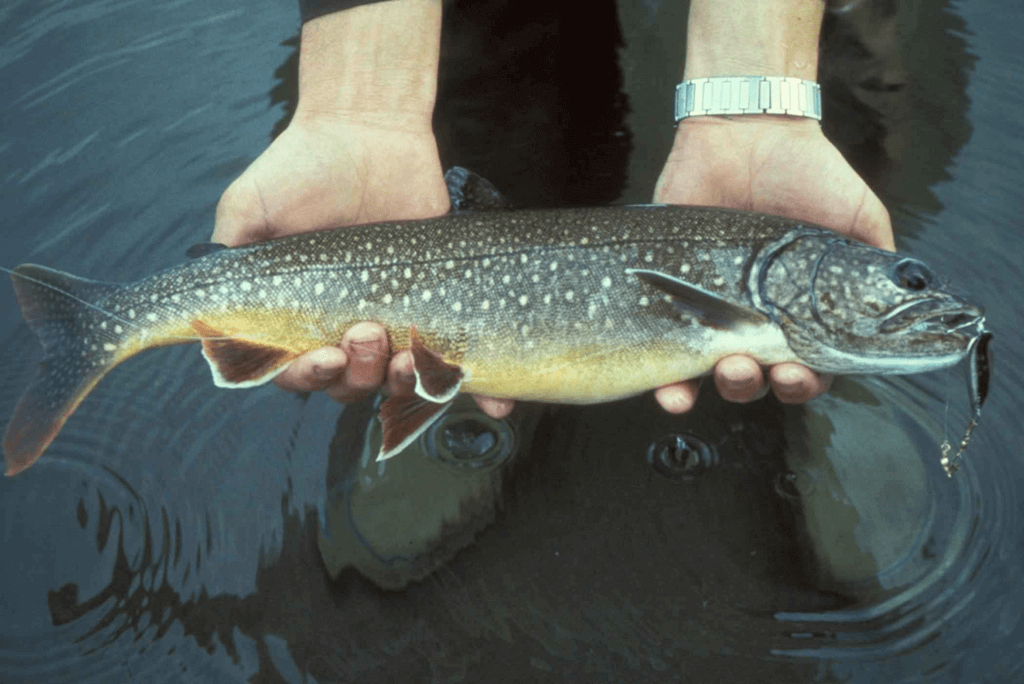
Lake trout (Salvelinus namaycush) are the big boys of the char family and they’re found in deep waters throughout the northern half of the country. You’ll find them in cold water reservoirs and lakes. In Canada, they are a serious game fish compared to the muskie or walleye down here.
Lake trout are rare, a challenge to track down, and even more of a pain to get in the boat if you hook one. If you do, prepare for a fight.
One other interesting fact about lake trout is their lifespan. They’re known to live as long as 40 years in remote places in Canada and Alaska. This means that you could luckily stumble upon something tremendously huge if you know where to go. Also, just imagine eating a 40 year old fish for a second. It sounds amazing and also kind of gross at the same time.
Anyway, their typical size is around 20-inches but finding lake trout as large as 50-inches isn’t uncommon. They’re also stocked throughout areas of the United States so you can find them in places outside of the New England and Great Lakes regions.
Catching Lake Trout
They feed on crustaceans, insects, and small fish so fishing these guys for baitfish is the way to go. One of the things that makes them so hard to catch is just reaching them because of the typical depth that they inhabit.
By the time you’re able to reach the appropriate depth in the water column, chances are, the other fish in the water will have already taken your bait or at least chewed it up to where the lake trout doesn’t want it now.
Bull Trout
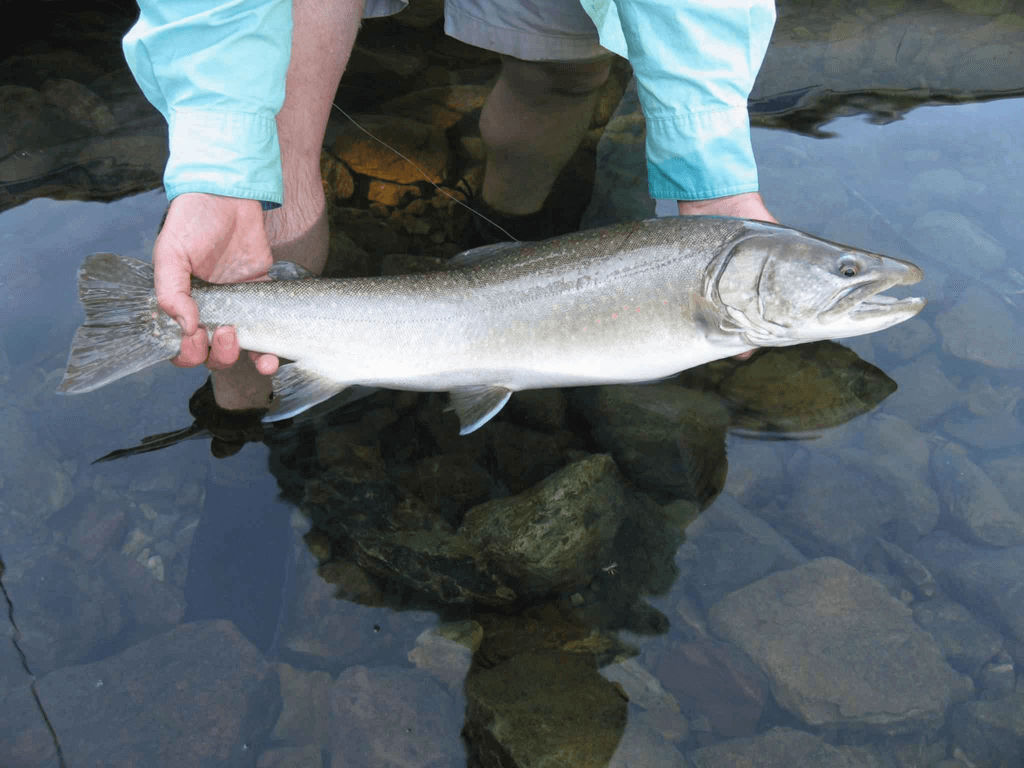
A close relative to the lake trout is the bull trout. These are one of the most popular species of char in the United States and you can expect to find them throughout the Pacific Northwest and the Southwestern region of Canada.
They can be identified by their copper colored belly, silver upper portion, brown eyes, and orange spots. There are many kinds of trout but these are absolutely beautiful.
Just like their brothers, they grow quite large in size as well up to 40-inches in length with most commonly found around 25-inches. They also have a long life span with most living around 15-years.
When we compare bull trout vs brook trout, their habitats are almost the same with one major difference. Bull trout are most common in near-arctic environments so you won’t find them as much in the United States as you would throughout Canada.
Catching Bull Trout
The best way to catch bull trout is by fishing with lures that mimic a natural baitfish presentation. You want to go with minnows and streamer-type flies. If you’re using hard-bodied lures, go with a spoon or crankbait.
Keep in mind that these are incredibly challenging fish because of their size so you’ll want to have a proper baitcasting reel and the right braided line.
Dolly Varden Trout
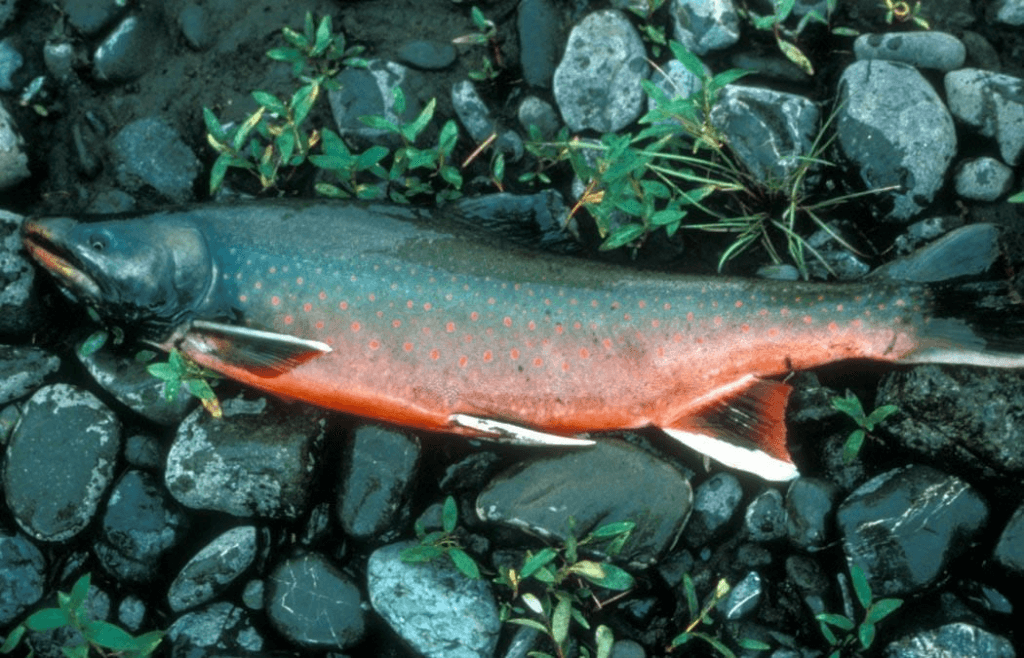
The debate door is wide-open on this one and feel free to chew me out in the comments but I do believe that the Dolly Varden is its own species of trout. A lot of people think it’s the same as an Arctic Char and for that reason, I haven’t even included Arctic Char in my list.
But, I just find there to be enough differences to consider them each their own fish.
You’ll find Dolly Varden throughout Alaska, down through Canada, and into parts of Northern Washington. One interesting fact is that they swam across the Pacific Ocean and people of Japan and Siberia have noticed a growth of the Dolly Varden population over there.
They’re not a huge species compared to Lake and bull trout but they’re bigger than your average brook and rainbow trout. They average about 10-pounds and you’ll identify them by their unique side stripe and spots.
The exact color of the stripe can vary but it usually looks like a teal color with pink spots. Other than that, they look a lot like a bull trout or species of cutthroat trout.
Catching Dolly Varden
These fish are incredibly aggressive especially during their spawn and they eat a wide-range of things so catching them isn’t too hard if you can locate them. They eat a lot of insects and larvae and will also feed on small fish.
Using a light action rod with spinners and spoons is the way to go. Powerbait is another solid option but going with all-natural salmon eggs is recommended.
The Hybrids: Crossing Over
There are a few interesting and unique hybrid species of trout available throughout North America and Canada. The chances of finding these are miniscule but I’ve seen some pretty crazy things.
Tiger Trout

If you had a brook trout vs brown trout catch match, you’d end up with a tiger trout. They might not look much like either but they do have more of that distinguishable worm pattern like a brook trout.
They’re not commonly found in the wild so you’ll have the best chance of catching them in a stocked lake throughout the great lake region. Tiger trout grow between 18-20 inches typically and they have an aggressive attitude that will bite a lot of different things.
Catching Tiger Trout
These guys can survive in a wide-range of habitats because of their hybrid design so you can expect them to actively feed for most of the season. Going with spinners, spoons, and live bait is the way to go because they don’t feed on insects, they only feed on other fish.
So, that makes tiger trout one of the only species of trout that you can’t catch with a fly.
Splake

When it comes to types of trout, splake is one that is heavily debated. They’re a mix between a female lake trout and a male brook trout. They grow quickly and you’ll find them primarily in the midwestern potion of the country. They don’t breed in the wild so they’re kept under lock and key in breeding locations throughout Canada.
Their name is actually a combination of speckled and lake trout. Since they were planted throughout the midwest and they’re a blend between lake trout and brook trout, they have a more versatile appetite and can handle varying temperatures including very cold and slightly warm.
Catching Splake
Fly fishing, spin casting, bait casting, and trolling are all ways to catch splake. These fish will bite almost anything and since they grow so fast they have a strong appetite and will feed a lot. Live bait such as fish eggs and small insects work great as well.
Palomino Trout

I really did save one of the coolest types of trout for last, the palomino trout. These are known as the golden rainbow trout but don’t get them confused with the golden trout from earlier in the article. These fish were genetically-mutated and designed in captivity throughout the 1950s.
It was a mutation from a rainbow trout that led to this bright gold-orange color that made them stand out dramatically from the other fish.
Of course, because of the bright color and large size it makes them a target for overfishing and bad practices.
Catching Palomino Trout
Within 25-50 miles of my hometown are sprawling rivers and streams known for housing incredible palomino trout. Pennsylvania is the ideal spot for catching these guys with some of them weighing as heavy as 13-pounds.
One thing is that palomino trout are highly sensitive and very skittish so present something that is very mild and don’t make too much noise with a loud outboard motor or too much movement. Go with a light action trout rod and a quality reel.
They also have a very powerful jump for a shallow water fish so you’ll want to have a net with you.
Final Thoughts
We covered 13 species of trout in this article. Out of all the types of trout here, most of us will only ever catch a few of them unless we’re very lucky. That said, it’s nice to be informed and know a thing or two about different trout species so you can show off to your buddies and the guys down at the local tackle shop.
Trout fishing offers a diverse and exciting range of species to target. That’s probably the reason why, next to bass fishing, trout are one of the most popular sport fish out there. If you have anything to add, feel free to leave a comment below – I read and answer them all!
Good luck out there!


